Container Line Mergers and Acquisitions: Operational and Market Trends
VerifiedAdded on 2020/04/21
|9
|1765
|248
Report
AI Summary
This report provides an in-depth analysis of the container line industry, focusing on the trends and impacts of mergers and acquisitions. It begins by examining the operational and managerial characteristics of the container liner sector, highlighting the role of container lines in global trade and the distinction between bulk and liner shipping. The report then delves into the trend toward market concentration through mergers and acquisitions, using the NYK-MOL-K.Line merger as a case study. It explores the drivers behind these mergers, such as the erosion of shipping rates and the need for economies of scale, and the operational benefits like cost reduction, improved service frequency, and broader port coverage. The report also discusses the challenges and limitations associated with mergers, the impact on shippers, and the increasing focus on resource sharing and alliances. The conclusion summarizes the key findings, emphasizing the importance of understanding these dynamics for stakeholders in the shipping industry. The report also mentions the technological advancements in ship construction and design along with ensuring economies of scale for bigger ships that can promote trade, specifically that of developing country through making goods transportation economical over long distances.
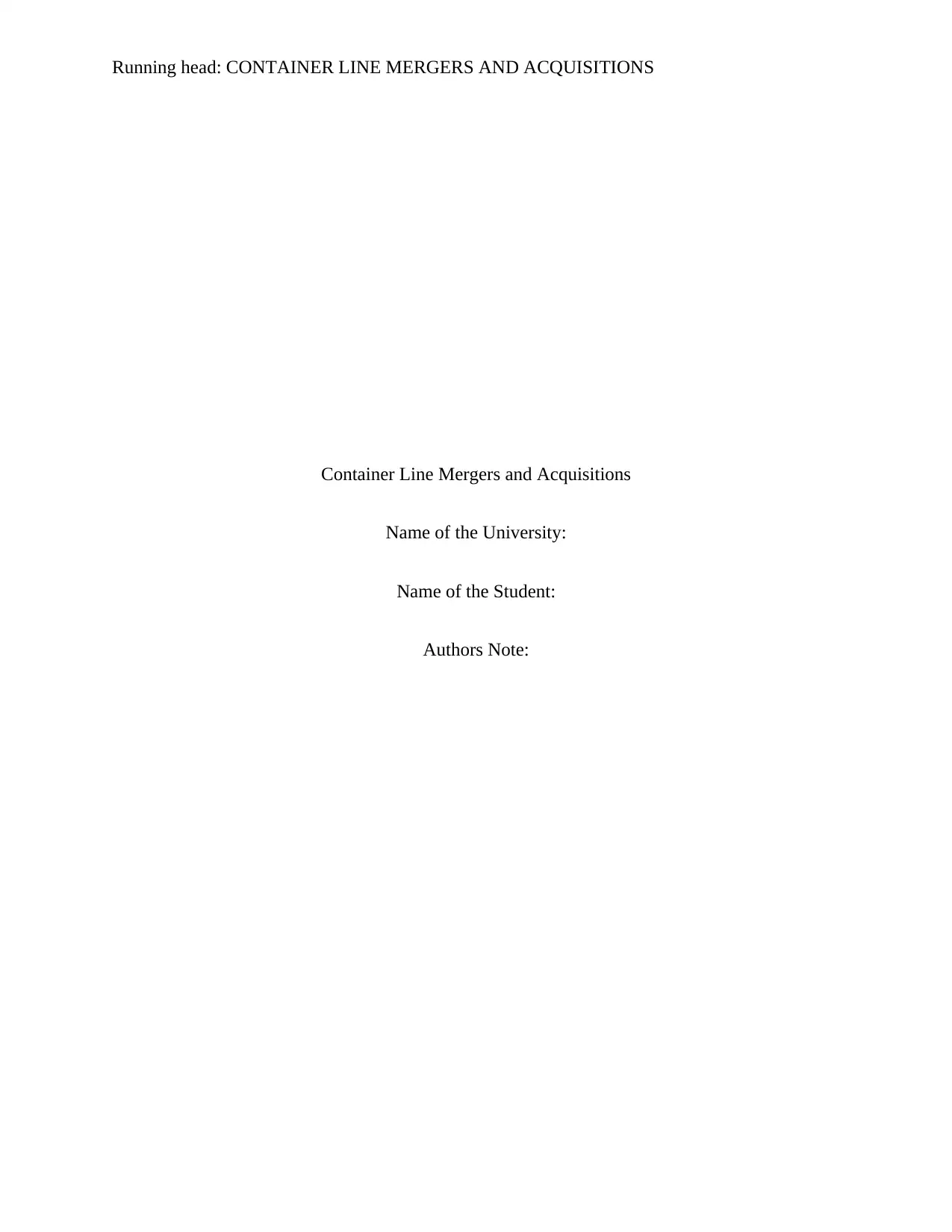
Running head: CONTAINER LINE MERGERS AND ACQUISITIONS
Container Line Mergers and Acquisitions
Name of the University:
Name of the Student:
Authors Note:
Container Line Mergers and Acquisitions
Name of the University:
Name of the Student:
Authors Note:
Paraphrase This Document
Need a fresh take? Get an instant paraphrase of this document with our AI Paraphraser
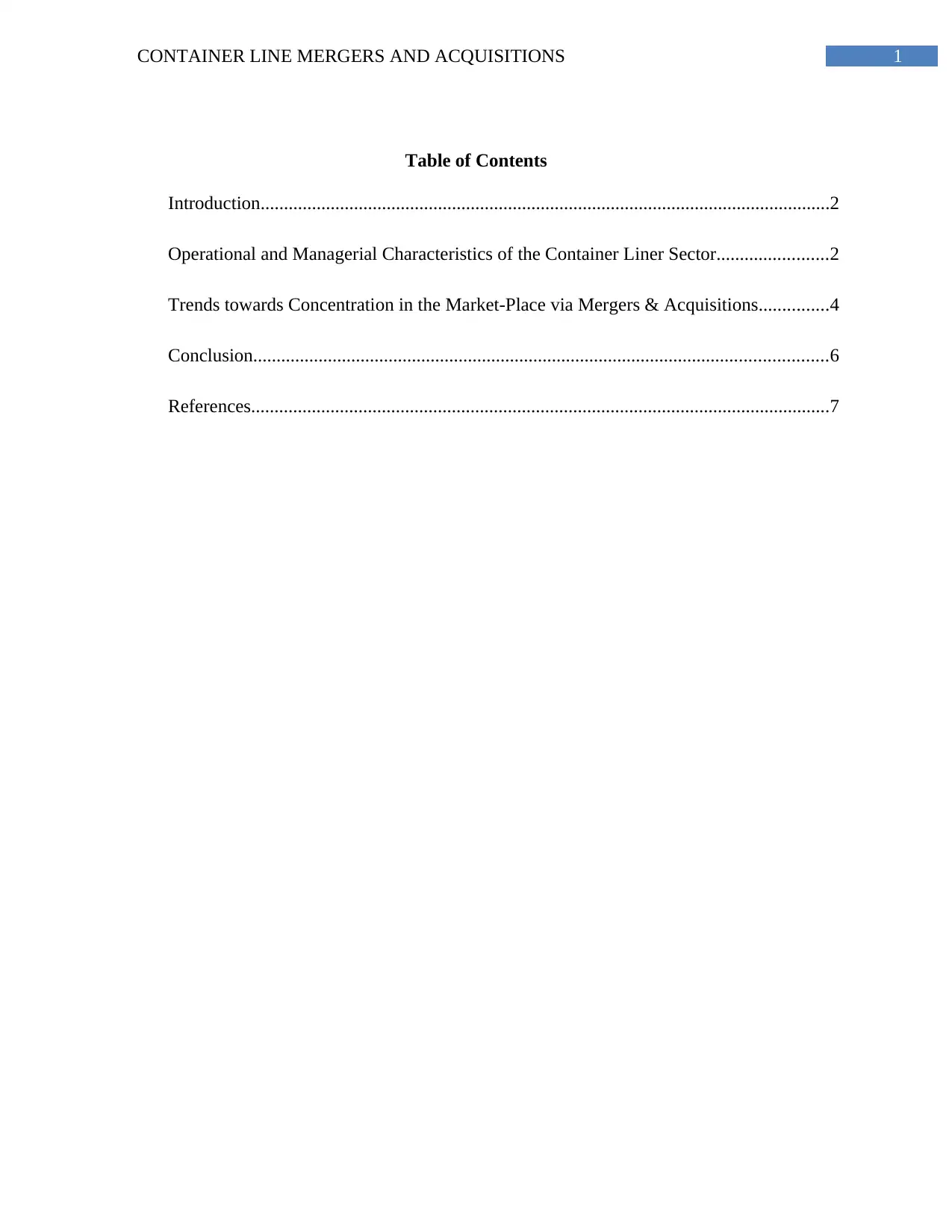
1CONTAINER LINE MERGERS AND ACQUISITIONS
Table of Contents
Introduction..........................................................................................................................2
Operational and Managerial Characteristics of the Container Liner Sector........................2
Trends towards Concentration in the Market-Place via Mergers & Acquisitions...............4
Conclusion...........................................................................................................................6
References............................................................................................................................7
Table of Contents
Introduction..........................................................................................................................2
Operational and Managerial Characteristics of the Container Liner Sector........................2
Trends towards Concentration in the Market-Place via Mergers & Acquisitions...............4
Conclusion...........................................................................................................................6
References............................................................................................................................7
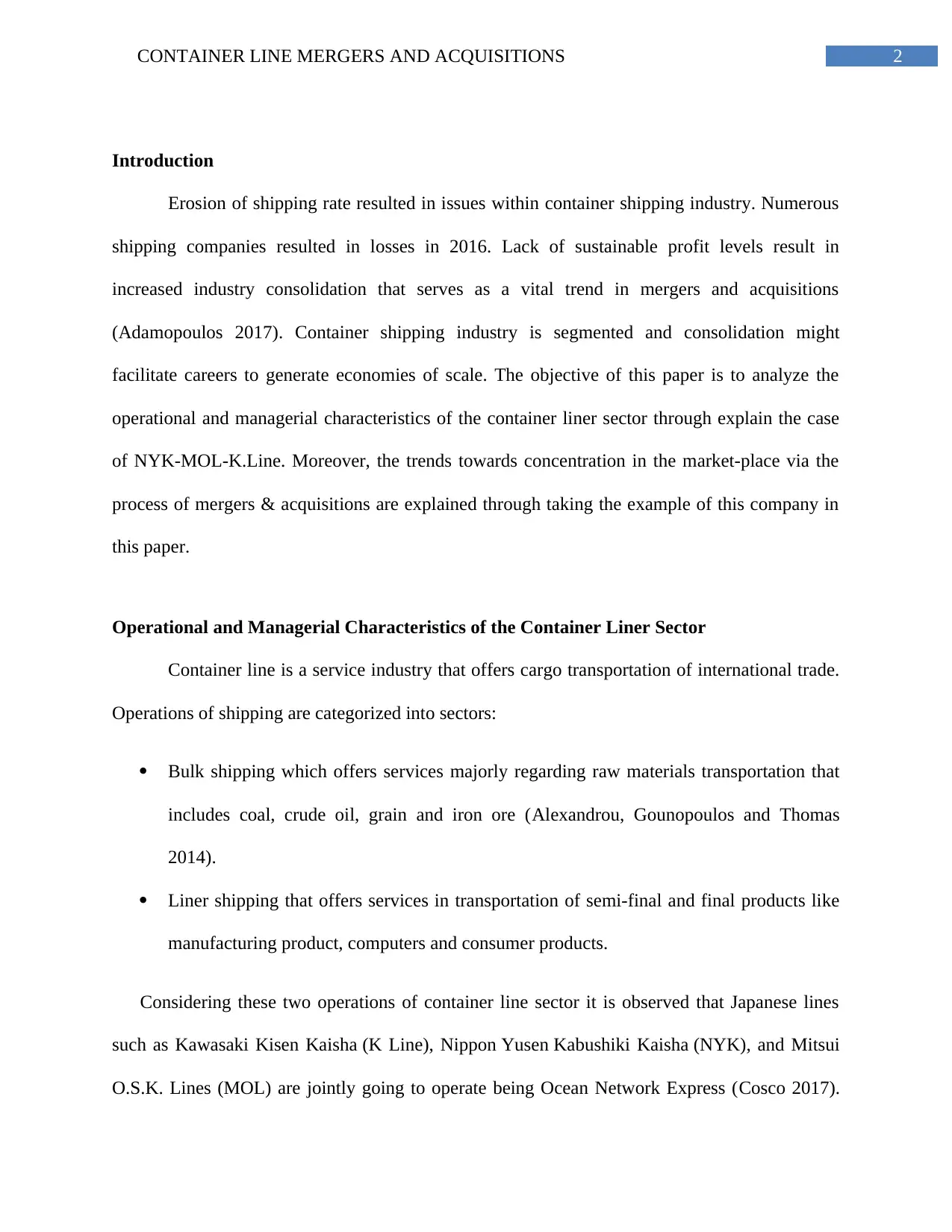
2CONTAINER LINE MERGERS AND ACQUISITIONS
Introduction
Erosion of shipping rate resulted in issues within container shipping industry. Numerous
shipping companies resulted in losses in 2016. Lack of sustainable profit levels result in
increased industry consolidation that serves as a vital trend in mergers and acquisitions
(Adamopoulos 2017). Container shipping industry is segmented and consolidation might
facilitate careers to generate economies of scale. The objective of this paper is to analyze the
operational and managerial characteristics of the container liner sector through explain the case
of NYK-MOL-K.Line. Moreover, the trends towards concentration in the market-place via the
process of mergers & acquisitions are explained through taking the example of this company in
this paper.
Operational and Managerial Characteristics of the Container Liner Sector
Container line is a service industry that offers cargo transportation of international trade.
Operations of shipping are categorized into sectors:
Bulk shipping which offers services majorly regarding raw materials transportation that
includes coal, crude oil, grain and iron ore (Alexandrou, Gounopoulos and Thomas
2014).
Liner shipping that offers services in transportation of semi-final and final products like
manufacturing product, computers and consumer products.
Considering these two operations of container line sector it is observed that Japanese lines
such as Kawasaki Kisen Kaisha (K Line), Nippon Yusen Kabushiki Kaisha (NYK), and Mitsui
O.S.K. Lines (MOL) are jointly going to operate being Ocean Network Express (Cosco 2017).
Introduction
Erosion of shipping rate resulted in issues within container shipping industry. Numerous
shipping companies resulted in losses in 2016. Lack of sustainable profit levels result in
increased industry consolidation that serves as a vital trend in mergers and acquisitions
(Adamopoulos 2017). Container shipping industry is segmented and consolidation might
facilitate careers to generate economies of scale. The objective of this paper is to analyze the
operational and managerial characteristics of the container liner sector through explain the case
of NYK-MOL-K.Line. Moreover, the trends towards concentration in the market-place via the
process of mergers & acquisitions are explained through taking the example of this company in
this paper.
Operational and Managerial Characteristics of the Container Liner Sector
Container line is a service industry that offers cargo transportation of international trade.
Operations of shipping are categorized into sectors:
Bulk shipping which offers services majorly regarding raw materials transportation that
includes coal, crude oil, grain and iron ore (Alexandrou, Gounopoulos and Thomas
2014).
Liner shipping that offers services in transportation of semi-final and final products like
manufacturing product, computers and consumer products.
Considering these two operations of container line sector it is observed that Japanese lines
such as Kawasaki Kisen Kaisha (K Line), Nippon Yusen Kabushiki Kaisha (NYK), and Mitsui
O.S.K. Lines (MOL) are jointly going to operate being Ocean Network Express (Cosco 2017).
⊘ This is a preview!⊘
Do you want full access?
Subscribe today to unlock all pages.

Trusted by 1+ million students worldwide
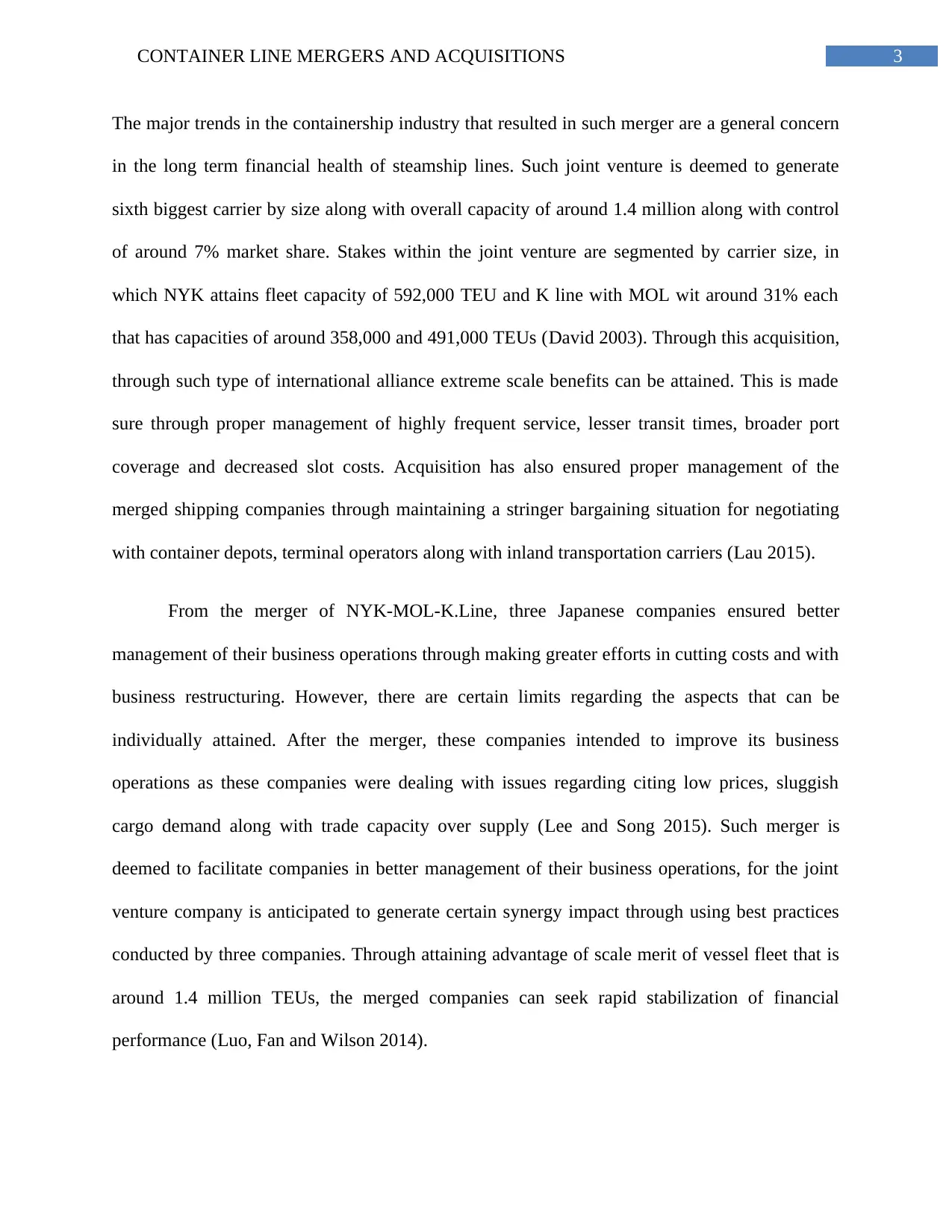
3CONTAINER LINE MERGERS AND ACQUISITIONS
The major trends in the containership industry that resulted in such merger are a general concern
in the long term financial health of steamship lines. Such joint venture is deemed to generate
sixth biggest carrier by size along with overall capacity of around 1.4 million along with control
of around 7% market share. Stakes within the joint venture are segmented by carrier size, in
which NYK attains fleet capacity of 592,000 TEU and K line with MOL wit around 31% each
that has capacities of around 358,000 and 491,000 TEUs (David 2003). Through this acquisition,
through such type of international alliance extreme scale benefits can be attained. This is made
sure through proper management of highly frequent service, lesser transit times, broader port
coverage and decreased slot costs. Acquisition has also ensured proper management of the
merged shipping companies through maintaining a stringer bargaining situation for negotiating
with container depots, terminal operators along with inland transportation carriers (Lau 2015).
From the merger of NYK-MOL-K.Line, three Japanese companies ensured better
management of their business operations through making greater efforts in cutting costs and with
business restructuring. However, there are certain limits regarding the aspects that can be
individually attained. After the merger, these companies intended to improve its business
operations as these companies were dealing with issues regarding citing low prices, sluggish
cargo demand along with trade capacity over supply (Lee and Song 2015). Such merger is
deemed to facilitate companies in better management of their business operations, for the joint
venture company is anticipated to generate certain synergy impact through using best practices
conducted by three companies. Through attaining advantage of scale merit of vessel fleet that is
around 1.4 million TEUs, the merged companies can seek rapid stabilization of financial
performance (Luo, Fan and Wilson 2014).
The major trends in the containership industry that resulted in such merger are a general concern
in the long term financial health of steamship lines. Such joint venture is deemed to generate
sixth biggest carrier by size along with overall capacity of around 1.4 million along with control
of around 7% market share. Stakes within the joint venture are segmented by carrier size, in
which NYK attains fleet capacity of 592,000 TEU and K line with MOL wit around 31% each
that has capacities of around 358,000 and 491,000 TEUs (David 2003). Through this acquisition,
through such type of international alliance extreme scale benefits can be attained. This is made
sure through proper management of highly frequent service, lesser transit times, broader port
coverage and decreased slot costs. Acquisition has also ensured proper management of the
merged shipping companies through maintaining a stringer bargaining situation for negotiating
with container depots, terminal operators along with inland transportation carriers (Lau 2015).
From the merger of NYK-MOL-K.Line, three Japanese companies ensured better
management of their business operations through making greater efforts in cutting costs and with
business restructuring. However, there are certain limits regarding the aspects that can be
individually attained. After the merger, these companies intended to improve its business
operations as these companies were dealing with issues regarding citing low prices, sluggish
cargo demand along with trade capacity over supply (Lee and Song 2015). Such merger is
deemed to facilitate companies in better management of their business operations, for the joint
venture company is anticipated to generate certain synergy impact through using best practices
conducted by three companies. Through attaining advantage of scale merit of vessel fleet that is
around 1.4 million TEUs, the merged companies can seek rapid stabilization of financial
performance (Luo, Fan and Wilson 2014).
Paraphrase This Document
Need a fresh take? Get an instant paraphrase of this document with our AI Paraphraser
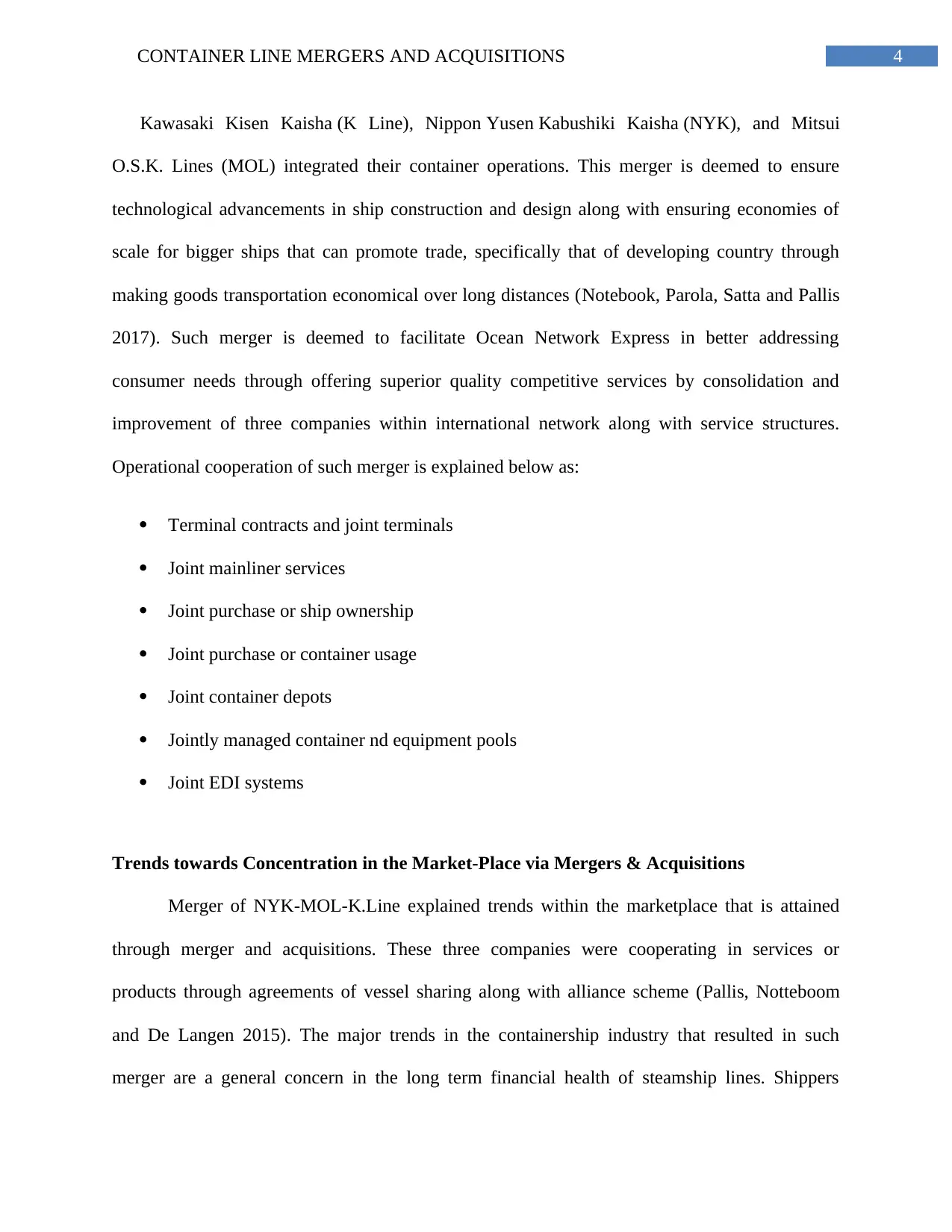
4CONTAINER LINE MERGERS AND ACQUISITIONS
Kawasaki Kisen Kaisha (K Line), Nippon Yusen Kabushiki Kaisha (NYK), and Mitsui
O.S.K. Lines (MOL) integrated their container operations. This merger is deemed to ensure
technological advancements in ship construction and design along with ensuring economies of
scale for bigger ships that can promote trade, specifically that of developing country through
making goods transportation economical over long distances (Notebook, Parola, Satta and Pallis
2017). Such merger is deemed to facilitate Ocean Network Express in better addressing
consumer needs through offering superior quality competitive services by consolidation and
improvement of three companies within international network along with service structures.
Operational cooperation of such merger is explained below as:
Terminal contracts and joint terminals
Joint mainliner services
Joint purchase or ship ownership
Joint purchase or container usage
Joint container depots
Jointly managed container nd equipment pools
Joint EDI systems
Trends towards Concentration in the Market-Place via Mergers & Acquisitions
Merger of NYK-MOL-K.Line explained trends within the marketplace that is attained
through merger and acquisitions. These three companies were cooperating in services or
products through agreements of vessel sharing along with alliance scheme (Pallis, Notteboom
and De Langen 2015). The major trends in the containership industry that resulted in such
merger are a general concern in the long term financial health of steamship lines. Shippers
Kawasaki Kisen Kaisha (K Line), Nippon Yusen Kabushiki Kaisha (NYK), and Mitsui
O.S.K. Lines (MOL) integrated their container operations. This merger is deemed to ensure
technological advancements in ship construction and design along with ensuring economies of
scale for bigger ships that can promote trade, specifically that of developing country through
making goods transportation economical over long distances (Notebook, Parola, Satta and Pallis
2017). Such merger is deemed to facilitate Ocean Network Express in better addressing
consumer needs through offering superior quality competitive services by consolidation and
improvement of three companies within international network along with service structures.
Operational cooperation of such merger is explained below as:
Terminal contracts and joint terminals
Joint mainliner services
Joint purchase or ship ownership
Joint purchase or container usage
Joint container depots
Jointly managed container nd equipment pools
Joint EDI systems
Trends towards Concentration in the Market-Place via Mergers & Acquisitions
Merger of NYK-MOL-K.Line explained trends within the marketplace that is attained
through merger and acquisitions. These three companies were cooperating in services or
products through agreements of vessel sharing along with alliance scheme (Pallis, Notteboom
and De Langen 2015). The major trends in the containership industry that resulted in such
merger are a general concern in the long term financial health of steamship lines. Shippers
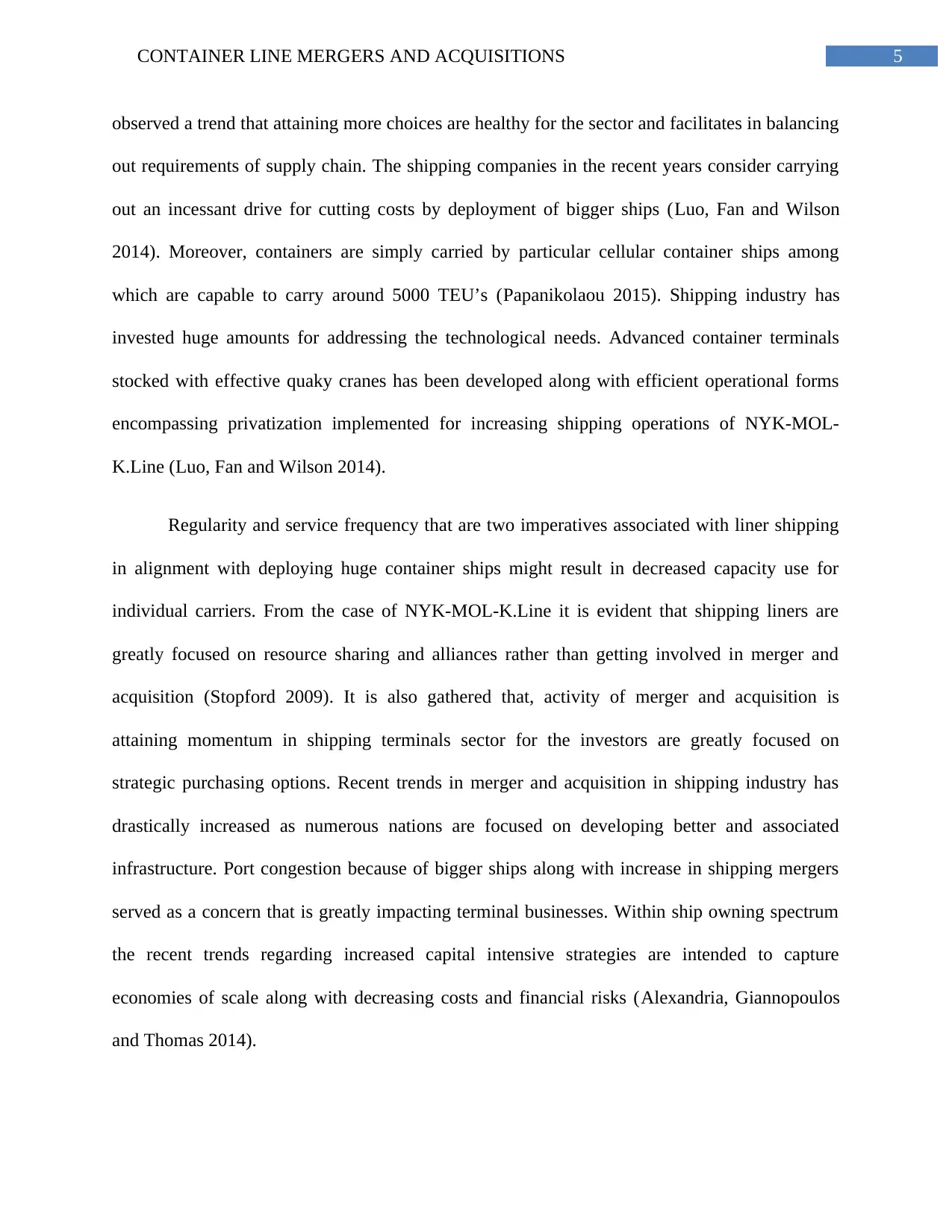
5CONTAINER LINE MERGERS AND ACQUISITIONS
observed a trend that attaining more choices are healthy for the sector and facilitates in balancing
out requirements of supply chain. The shipping companies in the recent years consider carrying
out an incessant drive for cutting costs by deployment of bigger ships (Luo, Fan and Wilson
2014). Moreover, containers are simply carried by particular cellular container ships among
which are capable to carry around 5000 TEU’s (Papanikolaou 2015). Shipping industry has
invested huge amounts for addressing the technological needs. Advanced container terminals
stocked with effective quaky cranes has been developed along with efficient operational forms
encompassing privatization implemented for increasing shipping operations of NYK-MOL-
K.Line (Luo, Fan and Wilson 2014).
Regularity and service frequency that are two imperatives associated with liner shipping
in alignment with deploying huge container ships might result in decreased capacity use for
individual carriers. From the case of NYK-MOL-K.Line it is evident that shipping liners are
greatly focused on resource sharing and alliances rather than getting involved in merger and
acquisition (Stopford 2009). It is also gathered that, activity of merger and acquisition is
attaining momentum in shipping terminals sector for the investors are greatly focused on
strategic purchasing options. Recent trends in merger and acquisition in shipping industry has
drastically increased as numerous nations are focused on developing better and associated
infrastructure. Port congestion because of bigger ships along with increase in shipping mergers
served as a concern that is greatly impacting terminal businesses. Within ship owning spectrum
the recent trends regarding increased capital intensive strategies are intended to capture
economies of scale along with decreasing costs and financial risks (Alexandria, Giannopoulos
and Thomas 2014).
observed a trend that attaining more choices are healthy for the sector and facilitates in balancing
out requirements of supply chain. The shipping companies in the recent years consider carrying
out an incessant drive for cutting costs by deployment of bigger ships (Luo, Fan and Wilson
2014). Moreover, containers are simply carried by particular cellular container ships among
which are capable to carry around 5000 TEU’s (Papanikolaou 2015). Shipping industry has
invested huge amounts for addressing the technological needs. Advanced container terminals
stocked with effective quaky cranes has been developed along with efficient operational forms
encompassing privatization implemented for increasing shipping operations of NYK-MOL-
K.Line (Luo, Fan and Wilson 2014).
Regularity and service frequency that are two imperatives associated with liner shipping
in alignment with deploying huge container ships might result in decreased capacity use for
individual carriers. From the case of NYK-MOL-K.Line it is evident that shipping liners are
greatly focused on resource sharing and alliances rather than getting involved in merger and
acquisition (Stopford 2009). It is also gathered that, activity of merger and acquisition is
attaining momentum in shipping terminals sector for the investors are greatly focused on
strategic purchasing options. Recent trends in merger and acquisition in shipping industry has
drastically increased as numerous nations are focused on developing better and associated
infrastructure. Port congestion because of bigger ships along with increase in shipping mergers
served as a concern that is greatly impacting terminal businesses. Within ship owning spectrum
the recent trends regarding increased capital intensive strategies are intended to capture
economies of scale along with decreasing costs and financial risks (Alexandria, Giannopoulos
and Thomas 2014).
⊘ This is a preview!⊘
Do you want full access?
Subscribe today to unlock all pages.

Trusted by 1+ million students worldwide
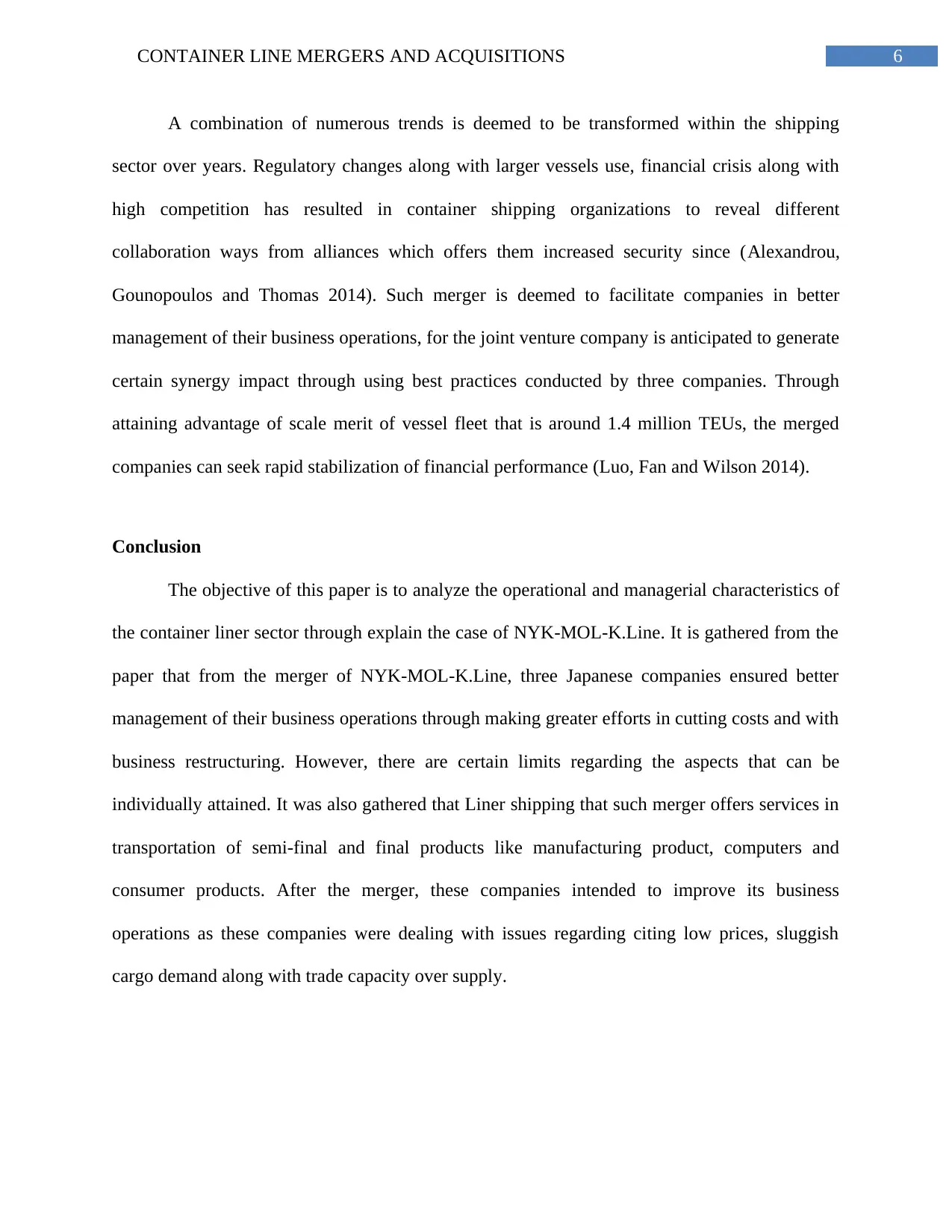
6CONTAINER LINE MERGERS AND ACQUISITIONS
A combination of numerous trends is deemed to be transformed within the shipping
sector over years. Regulatory changes along with larger vessels use, financial crisis along with
high competition has resulted in container shipping organizations to reveal different
collaboration ways from alliances which offers them increased security since (Alexandrou,
Gounopoulos and Thomas 2014). Such merger is deemed to facilitate companies in better
management of their business operations, for the joint venture company is anticipated to generate
certain synergy impact through using best practices conducted by three companies. Through
attaining advantage of scale merit of vessel fleet that is around 1.4 million TEUs, the merged
companies can seek rapid stabilization of financial performance (Luo, Fan and Wilson 2014).
Conclusion
The objective of this paper is to analyze the operational and managerial characteristics of
the container liner sector through explain the case of NYK-MOL-K.Line. It is gathered from the
paper that from the merger of NYK-MOL-K.Line, three Japanese companies ensured better
management of their business operations through making greater efforts in cutting costs and with
business restructuring. However, there are certain limits regarding the aspects that can be
individually attained. It was also gathered that Liner shipping that such merger offers services in
transportation of semi-final and final products like manufacturing product, computers and
consumer products. After the merger, these companies intended to improve its business
operations as these companies were dealing with issues regarding citing low prices, sluggish
cargo demand along with trade capacity over supply.
A combination of numerous trends is deemed to be transformed within the shipping
sector over years. Regulatory changes along with larger vessels use, financial crisis along with
high competition has resulted in container shipping organizations to reveal different
collaboration ways from alliances which offers them increased security since (Alexandrou,
Gounopoulos and Thomas 2014). Such merger is deemed to facilitate companies in better
management of their business operations, for the joint venture company is anticipated to generate
certain synergy impact through using best practices conducted by three companies. Through
attaining advantage of scale merit of vessel fleet that is around 1.4 million TEUs, the merged
companies can seek rapid stabilization of financial performance (Luo, Fan and Wilson 2014).
Conclusion
The objective of this paper is to analyze the operational and managerial characteristics of
the container liner sector through explain the case of NYK-MOL-K.Line. It is gathered from the
paper that from the merger of NYK-MOL-K.Line, three Japanese companies ensured better
management of their business operations through making greater efforts in cutting costs and with
business restructuring. However, there are certain limits regarding the aspects that can be
individually attained. It was also gathered that Liner shipping that such merger offers services in
transportation of semi-final and final products like manufacturing product, computers and
consumer products. After the merger, these companies intended to improve its business
operations as these companies were dealing with issues regarding citing low prices, sluggish
cargo demand along with trade capacity over supply.
Paraphrase This Document
Need a fresh take? Get an instant paraphrase of this document with our AI Paraphraser
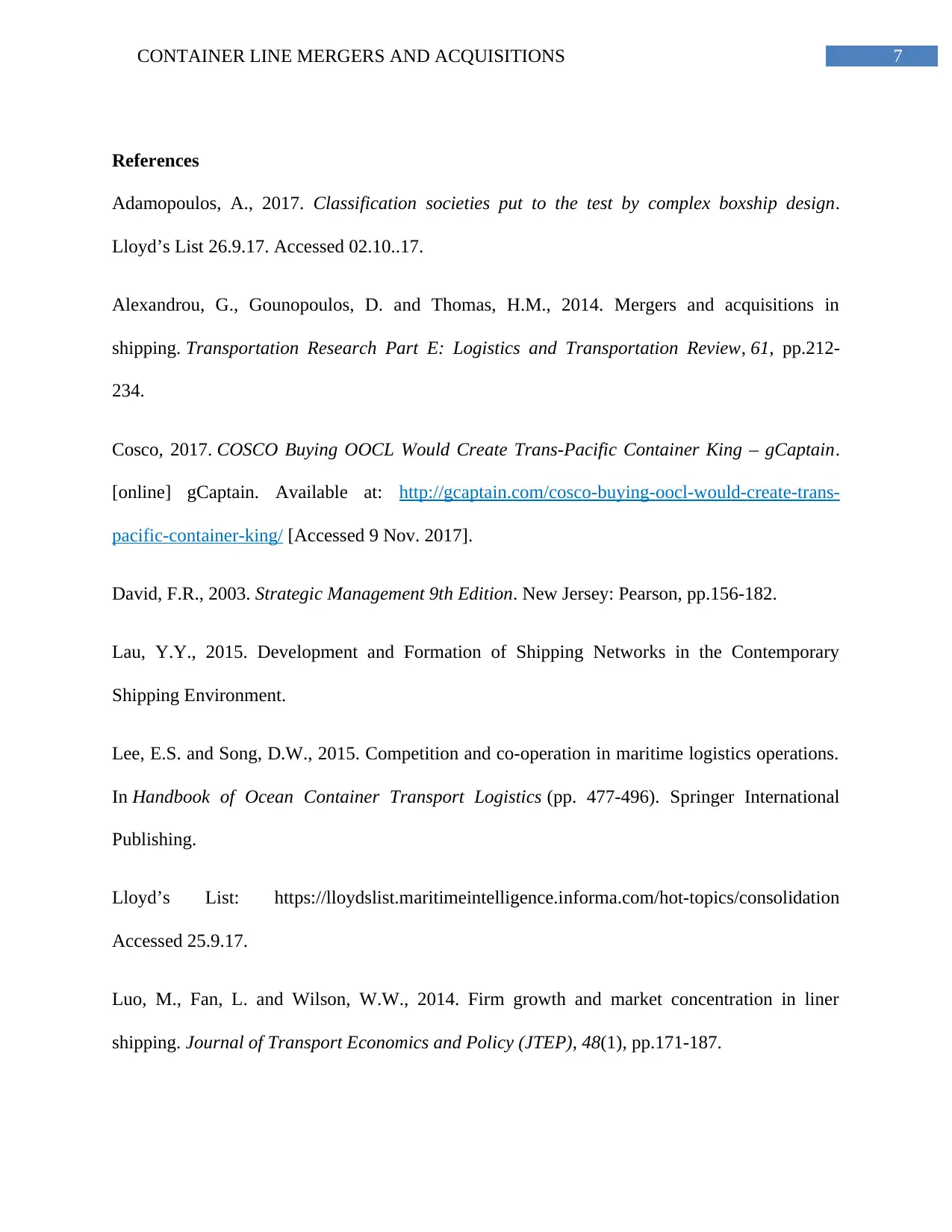
7CONTAINER LINE MERGERS AND ACQUISITIONS
References
Adamopoulos, A., 2017. Classification societies put to the test by complex boxship design.
Lloyd’s List 26.9.17. Accessed 02.10..17.
Alexandrou, G., Gounopoulos, D. and Thomas, H.M., 2014. Mergers and acquisitions in
shipping. Transportation Research Part E: Logistics and Transportation Review, 61, pp.212-
234.
Cosco, 2017. COSCO Buying OOCL Would Create Trans-Pacific Container King – gCaptain.
[online] gCaptain. Available at: http://gcaptain.com/cosco-buying-oocl-would-create-trans-
pacific-container-king/ [Accessed 9 Nov. 2017].
David, F.R., 2003. Strategic Management 9th Edition. New Jersey: Pearson, pp.156-182.
Lau, Y.Y., 2015. Development and Formation of Shipping Networks in the Contemporary
Shipping Environment.
Lee, E.S. and Song, D.W., 2015. Competition and co-operation in maritime logistics operations.
In Handbook of Ocean Container Transport Logistics (pp. 477-496). Springer International
Publishing.
Lloyd’s List: https://lloydslist.maritimeintelligence.informa.com/hot-topics/consolidation
Accessed 25.9.17.
Luo, M., Fan, L. and Wilson, W.W., 2014. Firm growth and market concentration in liner
shipping. Journal of Transport Economics and Policy (JTEP), 48(1), pp.171-187.
References
Adamopoulos, A., 2017. Classification societies put to the test by complex boxship design.
Lloyd’s List 26.9.17. Accessed 02.10..17.
Alexandrou, G., Gounopoulos, D. and Thomas, H.M., 2014. Mergers and acquisitions in
shipping. Transportation Research Part E: Logistics and Transportation Review, 61, pp.212-
234.
Cosco, 2017. COSCO Buying OOCL Would Create Trans-Pacific Container King – gCaptain.
[online] gCaptain. Available at: http://gcaptain.com/cosco-buying-oocl-would-create-trans-
pacific-container-king/ [Accessed 9 Nov. 2017].
David, F.R., 2003. Strategic Management 9th Edition. New Jersey: Pearson, pp.156-182.
Lau, Y.Y., 2015. Development and Formation of Shipping Networks in the Contemporary
Shipping Environment.
Lee, E.S. and Song, D.W., 2015. Competition and co-operation in maritime logistics operations.
In Handbook of Ocean Container Transport Logistics (pp. 477-496). Springer International
Publishing.
Lloyd’s List: https://lloydslist.maritimeintelligence.informa.com/hot-topics/consolidation
Accessed 25.9.17.
Luo, M., Fan, L. and Wilson, W.W., 2014. Firm growth and market concentration in liner
shipping. Journal of Transport Economics and Policy (JTEP), 48(1), pp.171-187.
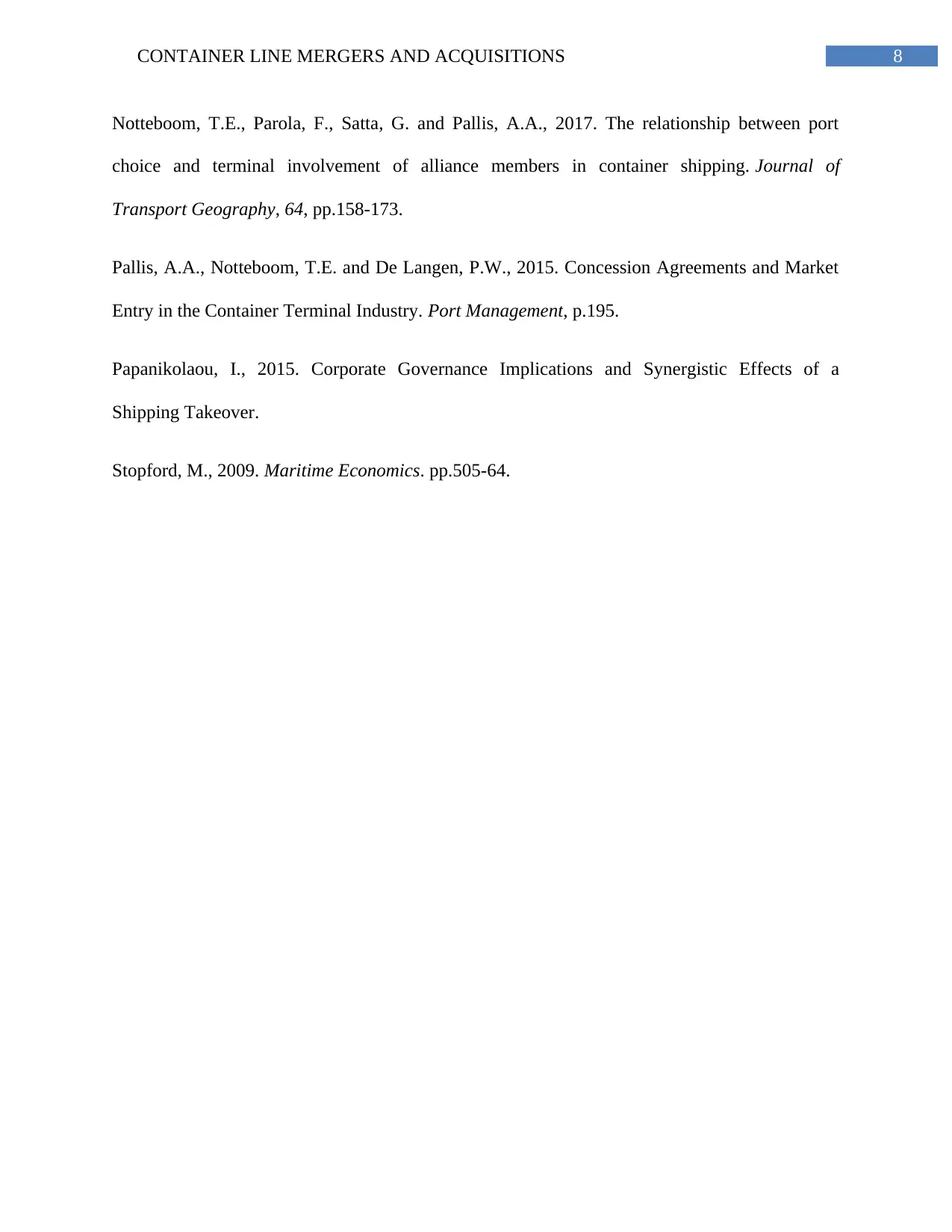
8CONTAINER LINE MERGERS AND ACQUISITIONS
Notteboom, T.E., Parola, F., Satta, G. and Pallis, A.A., 2017. The relationship between port
choice and terminal involvement of alliance members in container shipping. Journal of
Transport Geography, 64, pp.158-173.
Pallis, A.A., Notteboom, T.E. and De Langen, P.W., 2015. Concession Agreements and Market
Entry in the Container Terminal Industry. Port Management, p.195.
Papanikolaou, I., 2015. Corporate Governance Implications and Synergistic Effects of a
Shipping Takeover.
Stopford, M., 2009. Maritime Economics. pp.505-64.
Notteboom, T.E., Parola, F., Satta, G. and Pallis, A.A., 2017. The relationship between port
choice and terminal involvement of alliance members in container shipping. Journal of
Transport Geography, 64, pp.158-173.
Pallis, A.A., Notteboom, T.E. and De Langen, P.W., 2015. Concession Agreements and Market
Entry in the Container Terminal Industry. Port Management, p.195.
Papanikolaou, I., 2015. Corporate Governance Implications and Synergistic Effects of a
Shipping Takeover.
Stopford, M., 2009. Maritime Economics. pp.505-64.
⊘ This is a preview!⊘
Do you want full access?
Subscribe today to unlock all pages.

Trusted by 1+ million students worldwide
1 out of 9
Your All-in-One AI-Powered Toolkit for Academic Success.
+13062052269
info@desklib.com
Available 24*7 on WhatsApp / Email
![[object Object]](/_next/static/media/star-bottom.7253800d.svg)
Unlock your academic potential
Copyright © 2020–2025 A2Z Services. All Rights Reserved. Developed and managed by ZUCOL.